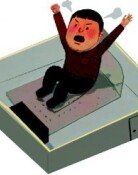Korean rescuer recalls horrific scenes after Japan quake
Korean rescuer recalls horrific scenes after Japan quake
Posted March. 08, 2014 03:10,
It was full of mud. There was no sign of a city. A car was seen horridly crushed, as it was placed at the rooftop of a destroyed house. Lying chaotically on the muddy floor were beverage cans that were washed out of a warehouse. Is it really a place where people were living?
This is the account of memories from the scene of the massive earthquake that hit East Japan on March 11, 2011, presented on Tuesday by Hwang Jae-dong, 49, senior firefighter and chief of the onsite control team, whom this reporter met at the 119 (911) Central Rescue Headquarters in Namyangju, Gyeonggi Province. Following suit of the first batch of the Korean rescue squad who was deployed on the next day of the earthquake, Hwang arrived in Sendai, Miyagi Prefecture, as a member of the second batch comprised of 102 members, by a military airplane.
The site was tragic indeed. Tsunamis had swallowed roads and buildings. Only mud-covered household items such as photo albums enabled the visitors to speculate that the area was a residential district. Deployed to countless fire, explosion and disaster sites, Hwang recalled it was the most hopeless scene he had ever seen.
In March last year, Sendai saw hails and had successive aftershocks. He felt sense of fear, but had no time to waste and hesitate. Leading Team 3 of the three Korean rescue teams at the site, Hwang started rescue mission. Two days passed since the powerful earthquake, but we believed that there would be survivors somewhere. We had to search and find people surviving, rather than the deceased.
The Korean rescue squad rummaged all different corners in Sendai, but couldn`t find any survivor at all. Only childrens school bags were seen piled up at classrooms of a school near the coast. The body of a female, who had apparently swept by tsunamis, was discovered on the rooftop of the school. Then, Hwang spotted something seemingly moving inside a vehicle that was stuck in the mud. Hwang opened a door after removing the mud, only to be taken aback. One man was found dead, with his hand holding the hand brake. The rescue squad discovered and collected 12 male bodies and six female bodies. After wrapping up the bodies with clothes, they gave silent tribute to them.
At the time of the East Japan Earthquake, rescue teams involving a total of 880 rescuers from 16 countries, including Russia, the U.S., Australia, Germany and China, took part in rescue operation. However, most of them withdrew half way through the rescue mission. It was because of escalating levels of radiation, which was leaked from Reactor 1 at Fukushima Nuclear Power Plant that had been destroyed by tsunamis. Despite the risk, however, the Korean rescue team remained in Sendai and continued search operation till the last day.
Hwang can hardly forget the moment he was searching a wooden house in Sendai. There was no one inside the house. I spotted a family photo. I also saw a childs baseball glove and twisted bicycle. I felt truly sad, wondering where that happy family had gone. He still vividly recollects the scene even these days once in a while.







